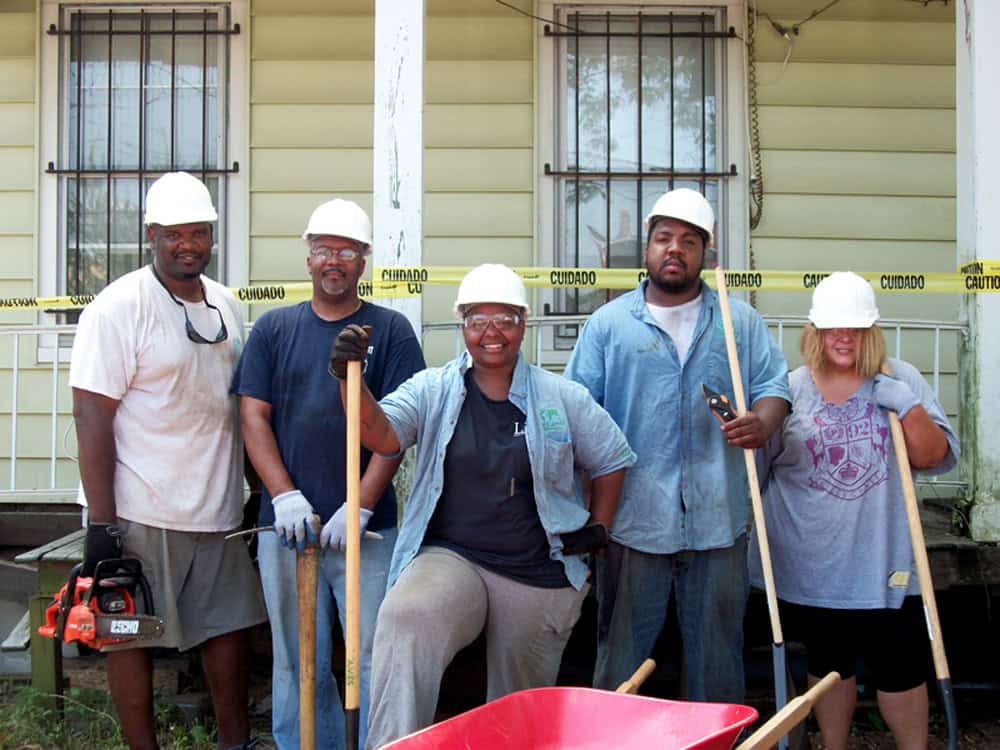In 2002, Adrienne Farrar Houël returned to the United States after a successful 25-year career in international marketing and real estate development in France, Russia and Ireland “to retire,” she said, laughing at the obvious contradiction. For the past two decades, Farrar Houël and her colleagues at Greater Bridgeport Community Enterprises have been anything but idle.
She describes relocating to Bridgeport, Connecticut, not far from where she grew up, as a wake-up call. What was clear to her was that the city lay at the crossroads of many problems that had negatively impacted the community’s public health outcomes.
Bridgeport is Connecticut’s largest city and is classified as both a disadvantaged area as far as economic development is concerned and as an area dealing with the effects of environmental injustice.
These designations are tied in part to the impacts of the coal plant that operated in Bridgeport’s South End region for decades.
“It’s been an industrial dumping ground, for lack of a better term,” said Farrar Houël. Being a coastal community in the lowest part of the city means the South End is subject to rising sea levels and frequent flooding from the city’s northern corridor. In addition to this, two major highways run through the middle of Bridgeport, which adds substantial air pollution to the area. “I thought, oh my God, these folks need some help!” Farrar Houël said.
Four years later, Farrar Houël launched Greater Bridgeport Community Enterprises (GBCE) with the goal of establishing environmental social impact projects in Bridgeport’s most historically disadvantaged communities. GBCE’s first initiative was the Green Team, a job development program training low-income Bridgeporters in residential remediation skill sets (such as removing asbestos, lead paint and mold from homes), carpentry and weatherization techniques. In addition to these occupational trainings, GBCE also assists participants in obtaining state certifications in their respective fields.
“We make sure that when they graduate, they get a stipend for equipment: PPE, boots, hard hat and tools,” Farrar Houël said. Program graduates have been hired for both city and private construction projects.
In 2012, Farrar Houël and GBCE launched Park City Green, a new project to address a waste management problem and a community workforce challenge in tandem. The solution for the latter problem focused on creating jobs for disadvantaged Bridgeporters, specifically formerly incarcerated citizens. The specific waste problem had to do with difficulties around the proper disposal of mattresses. Since they tend to be bulky and hard to move at times, old mattresses often got left on curbs, near roadsides or in vacant lots.
Disposing of them in landfills is also costly for municipalities and other entities, such as universities, hospitals and hotels. It’s also environmentally unsustainable. The Mattress Recycling Council estimates that more than 50,000 mattresses are discarded in the US every day.
“DEEP (Connecticut’s Department of Energy and Environmental Protection) wanted to get mattresses out of the waste stream,” said Farrar Houël. The state’s municipalities had been spending dearly on mattress disposal. The city of Hartford, for example, was paying $35 per mattress to incinerate them at a nearby waste-to-energy plant.
“Basically, the plant burns whatever comes in and the methane from that burn is captured and fed back into the grid for electricity purposes,” Farrar Houël said. “Seems like a good idea, but of course there’s lots of other stuff that gets burned off besides the methane.”
Farrar Houël consulted with Terry McDonald of the St. Vincent DePaul Society, who had designed a mattress recycling program in Lane County, Oregon by employing returning citizens to separate out 75 percent of the material in mattresses and box springs to be resold, in the creation of the sustainable mattress disposal program. Today, Park City Green employs 18-20 people and recycles some 70,000 mattresses per year, bringing in $800,000 to $1 million in annual revenue.
GBCE is also a member organization of the Bridgeport Regional Energy Partnership (BREP), an informal coalition of some 35 civic, cultural, economic, financial and governmental institutions. On its website, BREP lists as its highest priority reducing environmental injustice through collaborative community outreach efforts.
“We’re lucky in Bridgeport to have a state program called neighborhood urbanization zones,” said Farrar Houël. At monthly meetings of the South End urbanization zone, she says they always try to have as many local businesses, community action groups and schools represented as they can. They also bring in as many residents as possible to talk through energy concerns as well as any new building projects coming into the community.
Farrar Houël’s vision for future GBCE programming includes seeking state and federal funding to establish climate resiliency hubs, which would be centers where residents could take refuge during extreme weather events. These hubs would operate on renewable energy sources, such as microgrids, that can withstand a variety of natural disasters and would also serve as a central communication center for emergency service providers.
“The Red Cross and city emergency services could set up there and neighbors could stay until they’re able to get back into their homes,” she said. Farrar Houël also has plans to expand the Green Team into an official clean technology training academy and is actively working to bring more clean energy manufacturers to her state.
When asked about her drive to continue the important work of Greater Bridgeport Community Enterprises, Farrar Houël referenced her “triple bottom line of environmental sustainability”: to contribute to the social good by creating green jobs for disadvantaged residents, to build the city’s tax base by addressing unemployment and poverty and to revitalize Bridgeport’s neighborhoods. Acknowledging the heavy burden placed on the shoulders of those living in disadvantaged communities in Bridgeport, Farrar Houël is committed to creating opportunities like the ones she was fortunate enough to have for her fellow community members.
“My family expected that I would do as much as possible,” she said. “As it turns out, I was able to do a lot.”
Jennifer Bardi is a Contributing Writer.
Photo courtesy of Greater Bridgeport Community Enterprises.



